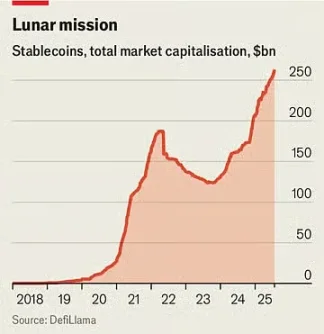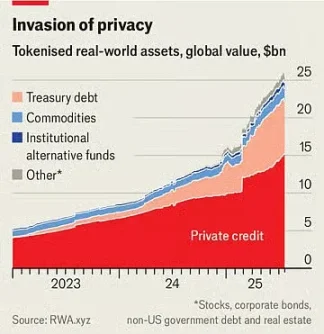The view that cryptocurrencies have yet to produce any noteworthy innovations has long since become a thing of the past.
Written by: The Economist
Translated by: Centreless
One thing is clear: the belief that cryptocurrencies have not yet generated any significant innovations is now outdated.
In the eyes of the conservative figures on Wall Street, the "use cases" of cryptocurrencies are often discussed with a tone of mockery. Veterans have seen it all before. Digital assets come and go, often with great fanfare, exciting investors who are keen on memecoins and NFTs. Beyond being tools for speculation and financial crime, their other uses have repeatedly been found to be flawed and inadequate.
However, the latest wave of enthusiasm is different.
On July 18, President Donald Trump signed the GENIUS Act, which provides the long-sought regulatory certainty for stablecoins (cryptographic tokens backed by traditional assets, usually the dollar). The industry is in a period of robust growth; Wall Street professionals are now eager to get involved. "Tokenization" is also on the rise: on-chain asset trading volumes are rapidly increasing, including stocks, money market funds, and even private equity and debt.
As with any revolution, the revolutionaries are ecstatic, while the conservatives are anxious.
Vlad Tenev, CEO of digital asset brokerage Robinhood, stated that this new technology could "lay the foundation for cryptocurrencies to become a pillar of the global financial system." European Central Bank President Christine Lagarde has a slightly different view. She worries that the emergence of stablecoins is akin to "the privatization of money."
Both sides recognize the scale of the transformation at hand. The mainstream market may face a more disruptive change than the early speculation in cryptocurrencies. Bitcoin and other cryptocurrencies promise to become digital gold, while tokens are merely wrappers or vehicles representing other assets. This may not sound particularly striking, but some of the most transformative innovations in modern finance have indeed changed the way assets are packaged, sliced, and restructured—exchange-traded funds (ETFs), Eurodollars, and securitized debt are typical examples.

Currently, the circulating value of stablecoins is $263 billion, an increase of about 60% from a year ago. Standard Chartered Bank predicts that the market value will reach $2 trillion in three years.
Last month, JPMorgan Chase, the largest bank in the U.S., announced plans to launch a stablecoin-like product called JPMD, despite CEO Jamie Dimon's long-standing skepticism towards cryptocurrencies.
The market value of tokenized assets is only $25 billion, but it has more than doubled in the past year. On June 30, Robinhood launched over 200 new tokens for European investors, allowing them to trade U.S. stocks and ETFs outside of normal trading hours.
Stablecoins make transactions cheap and fast because ownership is instantly recorded on a digital ledger, eliminating the need for intermediaries that operate traditional payment channels. This is particularly valuable for currently costly and slow cross-border transactions.
Although stablecoins currently account for less than 1% of global financial transactions, the GENIUS Act will provide a boost. The act confirms that stablecoins are not securities and requires that stablecoins must be fully backed by safe, liquid assets.
Retail giants, including Amazon and Walmart, are reportedly considering launching their own stablecoins. For consumers, these stablecoins may resemble gift cards, providing balances for spending at retailers, and they may be priced lower. This would eliminate companies like Mastercard and Visa, which facilitate sales in the U.S. with profit margins of about 2%.
Tokenized assets are digital copies of another asset, whether it be a fund, company stock, or a basket of commodities. Like stablecoins, they can make financial transactions faster and easier, especially for trades involving illiquid assets. Some products are merely gimmicks. Why tokenize stocks? Doing so might allow for 24-hour trading since the exchanges where stocks are listed do not need to be open, but the advantages of this approach are questionable. Moreover, for many retail investors, the marginal trading costs are already low, even zero.
Efforts to Tokenize
However, many products are not that flashy.
Take money market funds, for example, which invest in Treasury bills. A tokenized version could also serve as a payment method. These tokens, like stablecoins, are backed by safe assets and can be seamlessly exchanged on the blockchain. They also represent an investment that outperforms bank interest rates. The average interest rate on U.S. savings accounts is less than 0.6%; many money market funds yield as much as 4%. BlackRock's largest tokenized money market fund is currently valued at over $2 billion.
"I expect that one day, tokenized funds will be as familiar to investors as ETFs," wrote the company's CEO Larry Fink in a recent letter to investors.
This will have a disruptive impact on existing financial institutions.
Banks may be trying to enter the new digital packaging space, but part of the reason they are doing so is that they realize tokens pose a threat. The combination of stablecoins and tokenized money market funds could ultimately reduce the attractiveness of bank deposits.
The American Bankers Association points out that if banks lose about 10% of their $19 trillion in retail deposits (the cheapest source of funding), their average funding cost would rise from 2.03% to 2.27%. While the total amount of deposits, including commercial accounts, would not decrease, bank profit margins would be squeezed.
These new assets could also have a disruptive impact on the broader financial system.
For example, holders of Robinhood's new stock tokens do not actually own the underlying stocks. Technically, they own a derivative that tracks the asset's value (including any dividends paid by the company), rather than the stocks themselves. Therefore, they do not have the voting rights typically granted by stock ownership. If the token issuer goes bankrupt, holders will find themselves in a predicament, needing to compete with other creditors of the failed company for ownership of the underlying assets. A similar situation was faced by the fintech startup Linqto, which filed for bankruptcy earlier this month. The company had issued shares of private companies through special purpose vehicles. Buyers are now unclear whether they own the assets they believe they own.

This is one of the biggest opportunities of tokenization, but it also presents the greatest challenges for regulators. Pairing illiquid private assets with easily tradable tokens opens a closed market to millions of retail investors who have trillions of dollars to allocate. They can purchase shares in the most exciting private companies that are currently out of reach.
This raises questions.
Regulatory bodies like the U.S. Securities and Exchange Commission (SEC) have far more influence over public companies than private ones, which is why the former are suitable for retail investors. Tokens representing private shares would turn once-private equity into assets that can be traded as easily as ETFs. However, ETF issuers commit to providing intraday liquidity by trading the underlying assets, while token providers do not make such commitments. At a sufficiently large scale, tokens could effectively turn private companies into public ones without the usual disclosure requirements.
Even regulators who support cryptocurrencies want to draw a line.
SEC Commissioner Hester Peirce, known as "Crypto Mom" for her friendly stance towards digital currencies, emphasized in a statement on July 9 that tokens should not be used to circumvent securities laws. "Tokenized securities are still securities," she wrote. Therefore, regardless of whether securities take on a new cryptocurrency wrapper, companies issuing securities must comply with information disclosure rules. While this is theoretically reasonable, the large number of new assets with novel structures means that regulators will be in a perpetual game of catch-up in practice.
Thus, a paradox exists.
If stablecoins are indeed useful, they will also be truly disruptive. The more attractive tokenized assets are to brokers, customers, investors, merchants, and other financial companies, the more they can change finance, a change that is both exciting and concerning. Regardless of how the balance between the two plays out, one thing is clear: the belief that cryptocurrencies have not yet produced any noteworthy innovations has long since become a thing of the past.
免责声明:本文章仅代表作者个人观点,不代表本平台的立场和观点。本文章仅供信息分享,不构成对任何人的任何投资建议。用户与作者之间的任何争议,与本平台无关。如网页中刊载的文章或图片涉及侵权,请提供相关的权利证明和身份证明发送邮件到support@aicoin.com,本平台相关工作人员将会进行核查。




